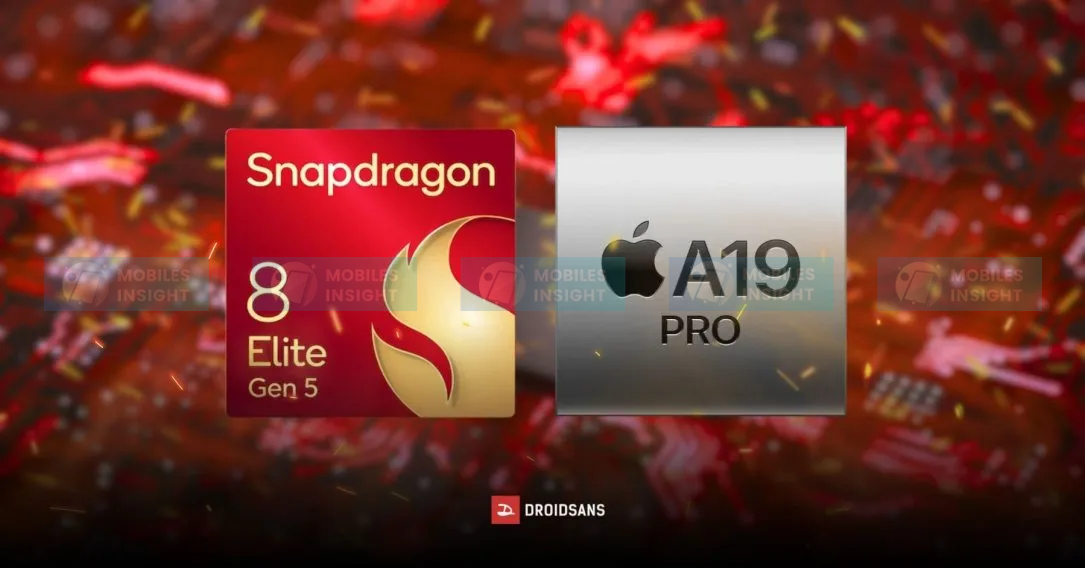
Snapdragon 8 Elite Gen 5 vs Apple A19 Pro: Gaming Benchmarks Revealed
The battle for mobile gaming is getting intense as Qualcomm’s Snapdragon 8 Elite Gen 5 goes up against Apple’s A19 Pro. Both chipsets come with powerful CPU and GPU upgrades, promising smooth gameplay, fast frame rates, and smarter AI graphics. Early gaming tests show how each processor handles big games, high-refresh screens, and heat management, giving gamers a clear idea of real-world performance. From quicker load times to better power efficiency, this comparison shows which chipset gives the best gaming experience in 2025 and beyond.
How Does the Snapdragon 8 Elite Gen 5 Match Apple’s A19 Pro?
The Snapdragon 8 Elite Gen 5 has closed the performance gap Apple once dominated. Benchmarks reveal near parity in single-core tasks and a 5% lead in multi-core processing. This improvement translates directly to faster app launches, smoother social media scrolling, and superior gaming physics.
- Single-Core Score: Snapdragon 3,831 | Apple A19 Pro 3,850
- Multi-Core Score: Snapdragon 11,525 | Apple A19 Pro 11,000
Xiaomi’s 17 Pro powered by Snapdragon 8 Elite Gen 5 demonstrates these gains in real-world performance. Tasks like video editing, AI-powered photo rendering, and resource-heavy games now run seamlessly.
Gaming Experience with Snapdragon 8 Elite
Gaming enthusiasts will notice higher frame rates, minimal throttling, and reduced heat generation. Qualcomm’s Gen 5 architecture optimizes power distribution across cores, allowing:
- Longer uninterrupted gaming sessions.
- Efficient battery utilization.
- Enhanced GPU rendering in AAA titles.
The A19 Pro maintains ecosystem-level optimization, but the Snapdragon 8 Elite Gen 5 matches it in performance while remaining flexible across Android devices.
Multi-Core Power: Why It Matters for Gamers
Multi-core improvements impact multitasking and parallel computations in games. Snapdragon 8 Elite Gen 5’s multi-core lead of 5% ensures smoother gameplay in titles with complex physics engines, such as open-world RPGs or mobile racing simulators.
- Better AI-driven NPC behavior in games.
- Faster texture loading and shader computations.
- Reduced lag during intensive multiplayer matches.
Efficiency and Real-World Usage
Apple's A19 Pro chip, built on TSMC's 3nm N3P process, offers significant power efficiency, delivering up to a 30% improvement in performance per watt compared to its predecessor. This efficiency is attributed to architectural advancements and a larger last-level cache for its energy-efficient cores. Even under sustained workloads, the A19 Pro maintains high performance with minimal thermal throttling, thanks to its advanced thermal management system, including a vapor chamber cooling solution.
On the other hand, the Snapdragon 8 Elite Gen 5, also fabricated on a 3nm process, exhibits impressive performance gains over its predecessor. In Geekbench 6 tests, it achieved a single-core score of 3,831 and a multi-core score of 11,515, outperforming the A19 Pro in multi-core tasks. However, early reports indicate that under heavy workloads, the Snapdragon 8 Elite Gen 5 may experience thermal throttling, with performance dropping to 74% of its maximum after 15 minutes and 77% after 60 minutes of stress testing.
In real-world scenarios, such as mobile gaming and cloud gaming, both chips offer robust performance. The A19 Pro's efficiency ensures prolonged gaming sessions with consistent frame rates, while the Snapdragon 8 Elite Gen 5 delivers high performance but may require optimized cooling solutions to maintain sustained performance.
Comparative Insights: Snapdragon vs A19 Pro
|
Features |
Snapdragon 8 Elite Gen 5 |
Apple A19 Pro |
|
Single-Core Performance |
3,831 |
3,850 |
|
Multi-Core Performance |
11,525 |
11,000 |
|
Gaming Frame Rates |
High, consistent |
High, optimized |
|
Thermal Management |
Minimal throttling |
Efficient, eco-friendly |
|
Real-World App Responsiveness |
Fast |
Very fast |
What Gamers Need to Know
In the mobile gaming arena of 2025, the Snapdragon 8 Elite Gen 5 and Apple A19 Pro stand out as top contenders. Here's how they compare:
- Single-Core Performance: The A19 Pro leads with a Geekbench 6 score of 3,895, surpassing the Snapdragon 8 Elite Gen 5's 3,831.
- Multi-Core Performance: The Snapdragon 8 Elite Gen 5 excels with a score of 11,525, outperforming the A19 Pro's 9,746.
- Graphics Performance: The A19 Pro's GPU is up to 40% faster than its predecessor, the A18 Pro, enhancing gaming visuals.
- Battery Efficiency: Both chips are built on TSMC's 3nm process, offering improved power efficiency for extended gaming sessions.
- Ecosystem Flexibility: The Snapdragon 8 Elite Gen 5 supports Android's diverse gaming ecosystem, providing a wide range of game titles and customization options.
In summary, while the A19 Pro offers superior single-core performance and graphics enhancements, the Snapdragon 8 Elite Gen 5 provides a balanced advantage in multi-core tasks and ecosystem versatility, making it a compelling choice for mobile gamers.
Final Thoughts
The Snapdragon 8 Elite Gen 5 has leveled the playing field with Apple’s A19 Pro. With multi-core superiority and gaming-focused architecture, it provides mobile users an unmatched experience across demanding apps, AI-driven tasks, and graphics-intensive games. Android enthusiasts now have a flagship chipset capable of rivaling Apple’s ecosystem performance.
Popular Phone Reviews

Samsung Galaxy A70 Review: Features, Performance, and Value Insights

Apple iPhone 16 Pro Max Review: Features, Performance, and Value Insights

Apple iPhone 12 Pro Max Review: Features, Performance, and Value Insights

Xiaomi Redmi 12 Review: Features, Performance, and Value Insights






